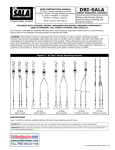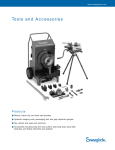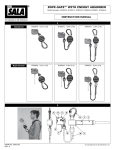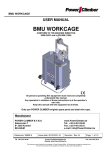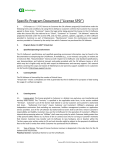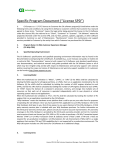Download USER INSTRUCTION MANUAL - Ultra-Safe
Transcript
USER INSTRUCTION MANUAL MODEL: 96602NS, 96602, 96602N, 96701S, 96701, 96702, 96701SAAA, 96702ACA, 96602ACA DESCRIPTION: REBAR ASSEMBLIES 1-800-850-5914 MEETS OSHA & ANSI Z359.1 PHOENIX, AZ USA WWW.ULTRASAFEUSA.COM MODEL: __________________________ SIZE: ____________________ DATE: ____________________ Anchorage: The anchorage to which this product is attached must be capable of sustaining a static load in the direction applied by the personal fall arrest system of at least 3600 lbs. with certification of a qualified person or 5000 lbs. without certification. When more than one personal fall arrest system is attached to the same structure, the strength requirements stated above must be multiplied by the number of personal arrest systems attached to the structure. Plan your personal fall protection system. Before installing and using this equipment, consider all factors affecting your safety during use of this equipment. 96602NS 96602N 96602 96701S 96602N 96701S 96702ACA 96602ACA Warning: Manufacturer's instructions supplied with this product at time of shipment must be followed. Failure to do so could result in serious injury or death. Contact manufacturer if instructions are needed. • Warnings and instructions must be read and understood before using equipment. • Equipment must be used by trained personnel only. • Users must understand all OSHA regulations, ANSI standards, and other relevant regulations and standards pertaining to fall protection equipment. This product is part of a personal fall arrest system; a fall arrest system is required if there is any risk that a worker may fall from an elevated position. It is a requirement that the fall arrest system be used any time a working height of six feet or more is reached. Working height is defined as the distance from the walking/working surface to a grade or lower level. The following is recommended as part of fall arrest system. A. Full Body Harness Material: Nylon 1. Back D-ring is for fall arrest 2. Shoulder D-rings (if present) are for retrieval use only. 3. Side D-rings (if present) are for positioning only. 4. Warning tags. Note: Maximum free-fall distance six feet or maximum fall arrest force of 1800 lbs. Avoid lower level contact. B. Shock Absorbing Lanyard Material: Nylon Warning tags located in front and back of shock absorber or located towards hook, D-ring or eye end. • Energy absorber resting force 900 lbs. Plus 42 inch maximum extension. • Rig lanyard to allow a maximum free fall distance of not more than six feet. • Connectors and anchorage points must be compatible and able to support 5,000 lbs. • Do not allow lanyard to contact sharp or abrasive surfaces, sparks or temperature above 180 degrees. • Snap hooks with gate openings larger than one inch (1") must not be connected to D-rings on harnesses and belts. • Remove from service if any damage is detected. C. Anchorage connector material: Nylon Warning tags are located towards hook, D-ring or eye end. • Use energy absorbers or retractable lanyards when hazard of free fall can occur. • Connectors and anchorage points must be compatible and able to support 5,000 lbs. Always work directly under anchorage to avoid a swing fall injury. • Anchorage and tie off points must be at a height that will not allow a lower level to be struck should a fall occur. Do not allow product to contact sharp or abrasive surfaces, sparks or temperatures above 180 degrees. • Snap hooks with gate openings larger than one inch (1”) must not be connected. • Remove from service if any damage is detected. 1 313RA1 Applications PURPOSE: The rebar lanyards are intended to be used as part of work positioning system that holds and supports the user at a work location. Applications include concrete rebar assembly and steel erection. OSHA standard 1926.500 defines this equipment as part of a positioning device system. LIMITATIONS: Consider the following application limitations before using this equipment: 1. CAPACITY: This equipment is designed for use by persons with a combined weight (including tools, clothing, etc.) of no more than 400 lbs. 2. FREE FALL: This equipment must be rigged to limit the potential free fall to 2 feet, according to OSHA 1926.502. 3. FALL CLEARANCE: Ensure that adequate clearance exists in your fall path to prevent striking an object. The clearance required is dependent on the length and type of lanyard and anchorage location. 4. PERSONAL FALL ARREST SYSTEM: Ultra-Safe recommends the use of a personal fall arrest system with this equipment. The personal fall arrest system will protect the user if the work positioning system disengages from the anchorage point, or when detached from the work positioning system when moving from point to point. See OSHA 1926.501 and 1926,1053. 5. ENVIRONMENTAL HAZARDS: Use of this equipment in areas where environmental hazards are present may require additional precautions to reduce the possibility of injury to the user or damage to the equipment. Hazards may include, but are not limited to; high heat, sever cold, caustic chemicals, corrosive environments, high voltage power lines, explosive or toxic gases, moving machinery, or sharp edges. 6. TRAINING: This equipment is intended to be used by persons trained in its correct application and use. APPLICABLE STANDARDS: Refer to national standards, including the ANSI Z359 family of standards on fall protection, ANSI A10.32, and applicable local, state, and federal (OSHA) requirements governing occupational safety, for more information on work positioning systems. ANCHORAGE STRENGTH: Anchorages selected for work positioning systems shall have a strength capable of sustaining static loads applied in the directions permitted by the system of at least: 3,000 pounds (13.3kN) for non-certified anchorages or Two times the forseeable force for certified anchorages. MAINTENANCE, SERVICING, STORAGE Clean the rebar lanyard with water and mild detergent. Wipe off hardware with a clean, dry cloth and hang to air dry. Do not force dry with heat. An excessive build-up of dirt, paint, etc., may prevent the rebar lanyard from working properly, and in severe cases, weaken the webbing. If you have questions about the condition of your rebar lanyard, contact Ultra-Safe. Additional maintenance and servicing procedures must be completed by Ultra-Safe or parties authorized in writing. Do not disassemble this equipment. Store the rebar lanyard in a cool, dry, clean environment, out of direct sunlight. Avoid areas where chemical vapors are present. Thoroughly inspect this equipment after extended storage. WARNING! This product is part of a personal fall arrest system. The user must read and follow the manufacturer’s instructions for each component of the system. These instructions must be provided to the user of this product. The user must read and understand these instructions before using this product. Manufacturer’s instructions must be followed for proper use and maintenance of this product. Alteration or misuse of this product, or failure to follow instructions may result in serious injury or death. 2 System Inspection Procedures General 1. Check for wear and deterioration. Before each use, carefully inspect your harness for signs of wear, deterioration, or evidence of impact loading. Visually inspect for loose threads, pulled rivets, burns, cuts, distortions, abrasions, or any other evidence of chemical or physical deterioration that may have weakened the material or assembly. 2. Inspect hardware for malfunctions and cracks. Check all snap hooks, buckles and D-Rings. 3. Remove from service and replace all worn or damaged equipment. If any part does not pass inspection, immediately remove the harness from service and destroy. Specific 1. Stitching and webbing. Check stitching for broken, burned, cut or pulled stitches. Broken strands appear as tufts on the surface. To inspect, hold the webbing with your hands six to eight inches apart. Bend the webbing in an inverted U to cause surface tension, exposing problem areas. Inspect all web areas. Damage from cuts, abrasion, corrosives, heat or chemicals should be apparent. 2. Buckle and belt ends. Inspect the ends of all straps. They are subject to wear as a result of repeated opening and closing. Enlargement or distortion of holes may indicate excessive wear or possible damage through impact loading. Harnesses with unusually enlarged or distorted holes should fail inspection. 3. D-Rings. All D-Rings should be checked for distortion. D-ring attachment points should be checked for unusual wear or damaged Fibers. Badly pitted D-rings indicate chemical corrosion, and the equipment should fail inspection. 4. Stitching or rivets at hardware attachment points. For stitched attachment points, check that stitching is not broken, burned, cut or pulled. Check all riveted attachment points for tightness. Badly pitted rivets indicate chemical corrosion, and the equipment should fail inspection. 5. Tongue buckles. All tongue buckles should be checked for distortion, sharp edges and cracks. The tongue should move freely and overlap the frame. Rollers should not be distorted and should roll freely. 6. Friction slide adjusters. Friction slide adjusters should be checked for sharp edges, distortion. Make sure that the outer bars and center bars are straight. Also check corners and attachment points for wear and cracks. 7. Easy-connect buckle. Easy-connect buckle (square rings) should be checked for distortion, sharp edges and cracks. For stitched attachment points, check that stitching is not broken, burned, cut or pulled. 8. Friction style buckle. Friction style buckles should be checked for sharp edges, cracks and distortion. Make sure outer bars and center bar are straight. Also check corners and attachment points for wear. 9. Leather. Leather should be soft and supple. Visually check leather for cracks tears, burns, brittleness or other signs of damage age or abuse. While the leather components of the system are not load bearing, damage to the leather is a sign that the entire harness MAY NOT be in acceptable condition. Re-inspect entire system. Leather should both look and feel good. 1O. Destroy or replace worn or damaged Harnesses. If evidence of excessive wear, deterioration or mechanical malefaction is observed; the harness should be destroyed. Never work with worn or damaged equipment. Using damaged or worn equipment can cause serious injury or death. 11. The inspector is the most important part of any inspection procedure. Check all equipment thoroughly and follow all safety procedures and guidelines. Don't take any shortcuts. IMPORTANT NOTE: OSHA specifies that all employers covered by the Occupational Safety and Health Act are responsible for inspection and maintenance of all tools and equipment used by employees, whether owned by the employees or by the company. All Ultra-Safe equipment should be inspected before each use, and immediately removed from service if equipment does not pass inspection. INSPECTION AND MAINTENANCE LOG Serial Number: Model Number: Date Purchased: Inspection Date Date of First Use: Inspection Items Noted Corrective Action Approved By: Approved By: Approved By: Approved By: Approved By: Approved By: Approved By: Approved By: 3 Maintenance Performed Inspection Date Inspection Items Noted Corrective Action Maintenance Performed Approved By: Approved By: Approved By: Approved By: Approved By: Approved By: Approved By: Approved By: Approved By: Approved By: Approved By: Approved By: INSPECTION AND MAINTENANCE LOG WARNING! The user must read and understand these instructions or have them explained to them, before using this equipment. Failure to follow instructions may result in serious injury or death. 4






